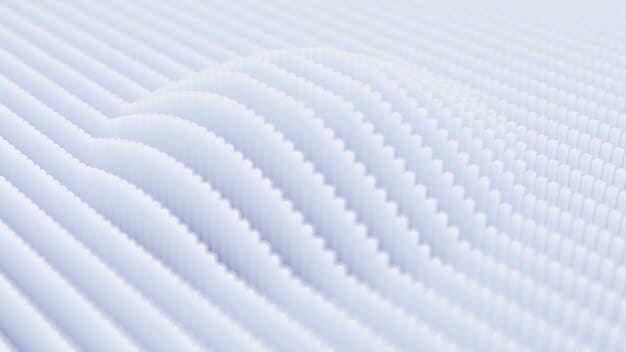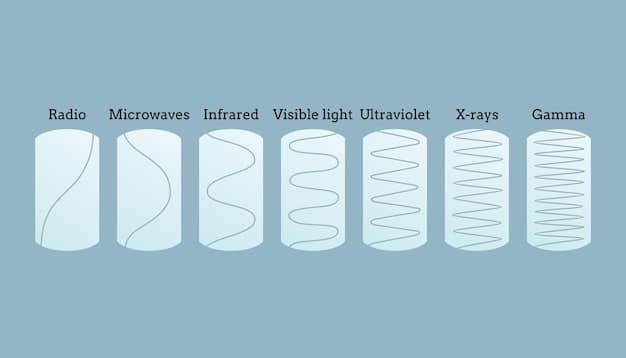The Ultimate Guide to Choosing the Right Mattress for a Good Night’s Sleep

Advertisements
Choosing the right mattress is crucial for achieving a restful night’s sleep; this guide provides comprehensive insights into mattress types, materials, firmness levels, and key considerations to ensure you select the perfect mattress for your individual needs and preferences.
A good night’s sleep starts with the right mattress. In The Ultimate Guide to Choosing the Right Mattress for a Good Night’s Sleep, we’ll explore everything you need to know to make an informed decision.
Advertisements
Understanding Mattress Types
When it comes to mattresses, one size definitely doesn’t fit all. Different types of mattresses offer unique benefits and cater to various sleep preferences.
Understanding the different types available is the first step in making the right choice.
Advertisements
Innerspring Mattresses
Innerspring mattresses are a classic choice, known for their bouncy feel and affordability. They consist of a coil system that provides support and structure.
Memory Foam Mattresses
Memory foam mattresses conform to your body, offering excellent pressure relief and motion isolation. They are ideal for those who experience joint pain or sleep with a partner.
- Pros: Excellent pressure relief, good motion isolation.
- Cons: Can trap heat, may have an initial odor.
- Best For: Side sleepers, couples, those with joint pain.
Innerspring and Memory Foam mattresses are widely available and offer varied comfort levels.
Decoding Mattress Materials and Construction
The materials used in a mattress play a significant role in its comfort, durability, and overall sleep experience. Getting familiar with these elements will boost your buying power.
From natural latex to advanced cooling technologies, understanding mattress materials is key.

Layers of different materials work together to provide sleep comfort.
Foam Density
Foam density refers to the weight of the foam per cubic foot. Higher density foams tend to be more durable and provide better support.
Coil Counts and Gauge
Coil count refers to the number of coils in an innerspring mattress. Higher coil counts generally offer better support. Coil gauge refers to the thickness of the coils; lower gauge coils are firmer.
- Latex: Natural material, hypoallergenic, durable, and responsive.
- Memory Foam: Conforms to the body, great for pressure relief.
- Polyfoam: Affordable, used for comfort layers.
Paying attention to these specifications can help you find a mattress that is both supportive and comfortable.
Identifying Your Sleep Style and Preferences
Your sleep style greatly influences the type of mattress that will work best for you. Consider whether you are a side, back, or stomach sleeper.
Understanding your sleep style is crucial for selecting the right mattress.
The position that you often take while falling asleep is important to know.
Side Sleepers
Side sleepers typically benefit from softer mattresses that contour to their body and relieve pressure on their hips and shoulders.
Back Sleepers
Back sleepers generally prefer medium-firm mattresses that provide support for their spine and prevent lower back pain.
- Side Sleeper: Soft to medium mattress, pressure relief.
- Back Sleeper: Medium to firm mattress, spinal support.
- Stomach Sleeper: Firm mattress, prevents sinking.
Aligning your mattress choice with your primary sleep position will likely improve your overall sleep quality.
Assessing Firmness Levels and Comfort
Mattress firmness is a subjective measure of how hard or soft a mattress feels. It’s important to find a firmness level that provides the right balance of comfort and support.
Understanding the relationship between firmness and comfort is vital.

Most mattresses fall between soft and very firm.
Soft Mattresses
Soft mattresses are plush and offer a lot of cushioning. They are often preferred by side sleepers and those who like a sinking feeling.
Firm Mattresses
Firm mattresses provide strong support and are ideal for stomach and back sleepers who need extra spinal alignment.
- Soft: For side sleepers, provides cushioning.
- Medium: Balanced support and comfort.
- Firm: For back and stomach sleepers, provides support.
Experimenting with different firmness levels in-store is often a good strategy when searching for a new mattress.
Considering Special Features and Technologies
Many modern mattresses come with special features and technologies designed to enhance your sleep experience. From cooling gels to adjustable bases, these additions can significantly improve your comfort.
Exploring innovative technologies can lead to a better night’s sleep.
Some special features are designed with dual functionality.
Cooling Technologies
Mattresses with cooling technologies, such as gel-infused foam or breathable covers, can help regulate temperature and prevent overheating during the night.
Adjustable Bases
Adjustable bases allow you to customize the position of your mattress, providing enhanced support and comfort for reading, watching TV, or alleviating medical conditions.
- Cooling Gel: Regulates temperature.
- Adjustable Base: Customizable positions.
- Motion Isolation: Reduces partner disturbance.
Taking advantage of these innovations can make a noticeable difference in your sleep quality.
Budgeting and Making a Purchase
Setting a budget is an essential step in the mattress-buying process. Mattresses range widely in price, so it’s important to determine how much you’re willing to spend.
The price range for new mattresses extends between low to high, so research is key.
Finding a mattress on a budget is possible with some careful consideration.
Set a Realistic Budget
Consider how long you expect the mattress to last and factor in the potential health benefits of a better night’s sleep.
Read Reviews and Compare Prices
Before making a purchase, read online reviews and compare prices from different retailers to ensure you’re getting the best deal.
- Budget: Determine how much you can spend.
- Reviews: Read customer experiences.
- Warranty: Check the length.
By following these steps, you can make a confident purchase that fits both your needs and your budget.
| Key Point | Brief Description |
|---|---|
| 🛏️ Mattress Type | Choose between innerspring, memory foam, latex, and hybrid options based on your needs. |
| 🛌 Sleep Style | Determine if you are a side, back, or stomach sleeper to select the right firmness. |
| 💰 Budget | Set a realistic budget and compare prices to find the best deal. |
| 🌡️ Cooling Tech | Consider features like gel-infused foam or breathable covers for temperature regulation. |
Frequently Asked Questions
▼
A medium-firm mattress is generally recommended. It provides adequate support to align the spine properly, reducing pressure points and preventing further discomfort.
▼
Typically, mattresses should be replaced every 7-10 years. However, if you notice signs of wear, such as sagging or discomfort, it may be time for a new one sooner.
▼
Yes, absolutely. An uncomfortable mattress can lead to tossing and turning, disrupt sleep cycles, and result in fatigue. Choosing the right mattress significantly improves comfort.
▼
A hybrid mattress combines multiple support systems, typically innerspring coils with foam layers. This design offers the benefits of both technologies, providing support and comfort.
▼
Both options have pros and cons. Buying in-store allows you to test the mattress, while online retailers offer convenience and often have lower prices. Consider your preferences.
Conclusion
Choosing the right mattress is an investment in your health and well-being. By understanding the various types, materials, firmness levels, and technologies available, you can make an informed decision that leads to restful nights and energized days. Take the time to research and test different options to find the perfect mattress for your individual needs.